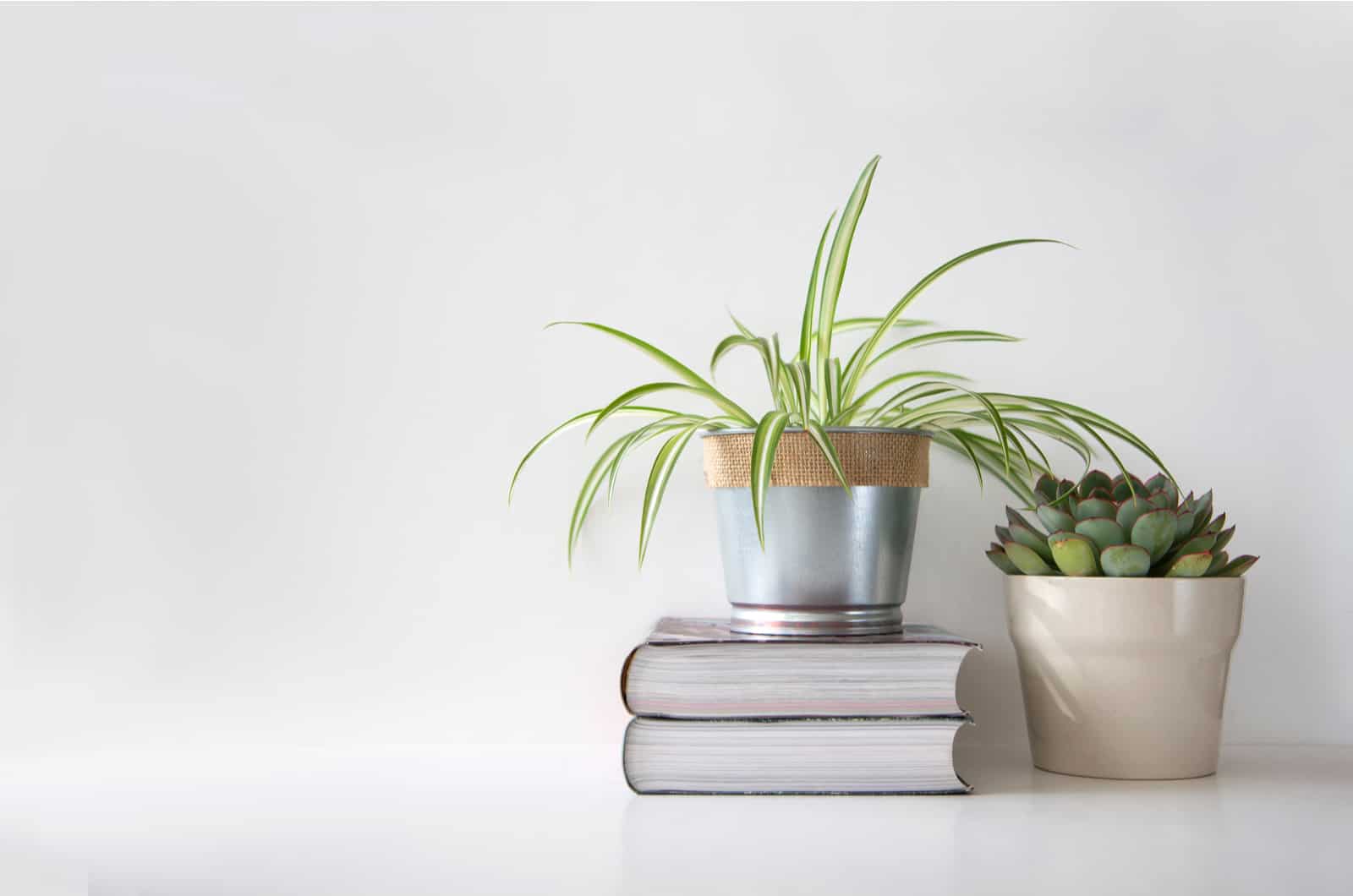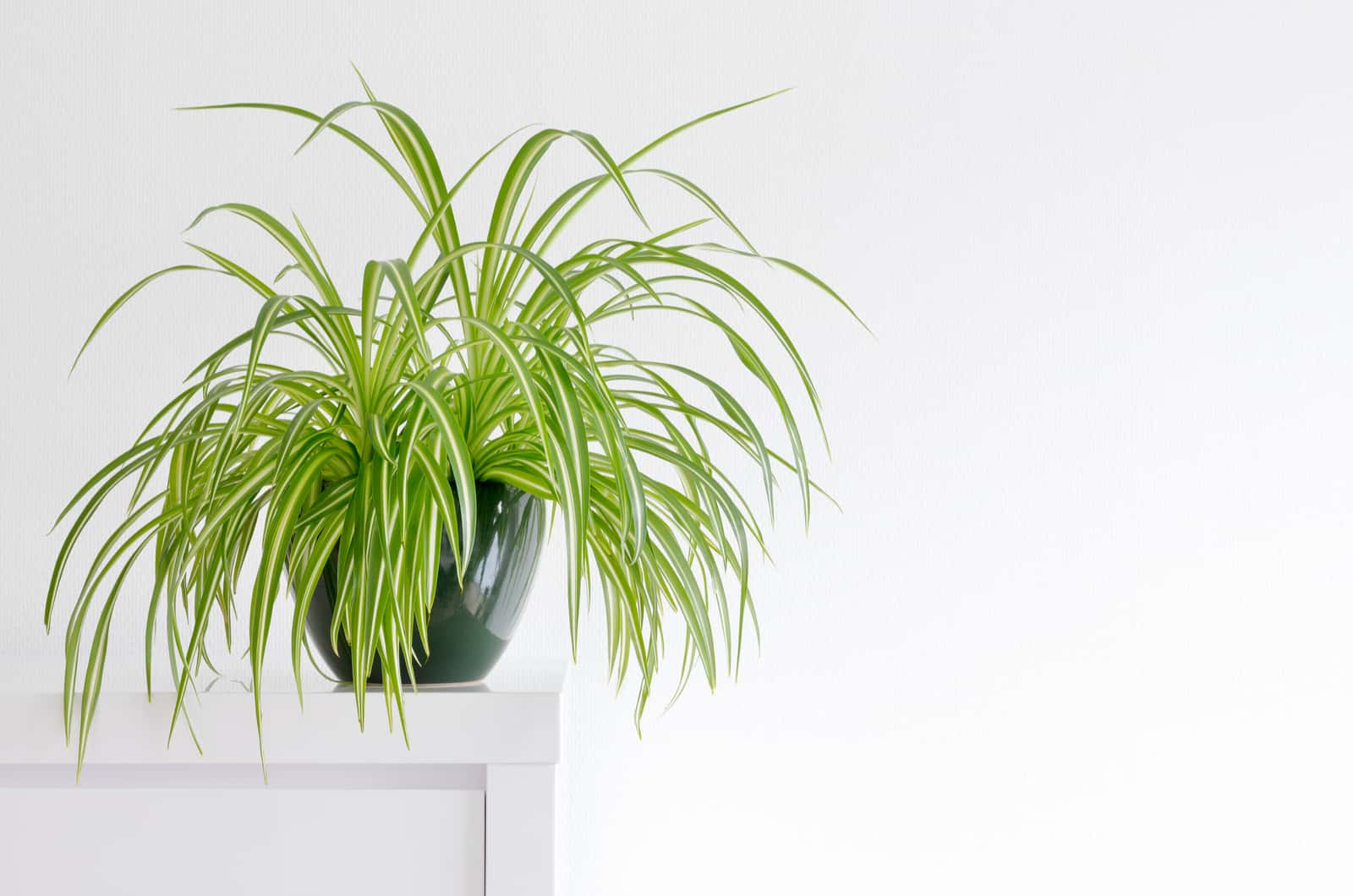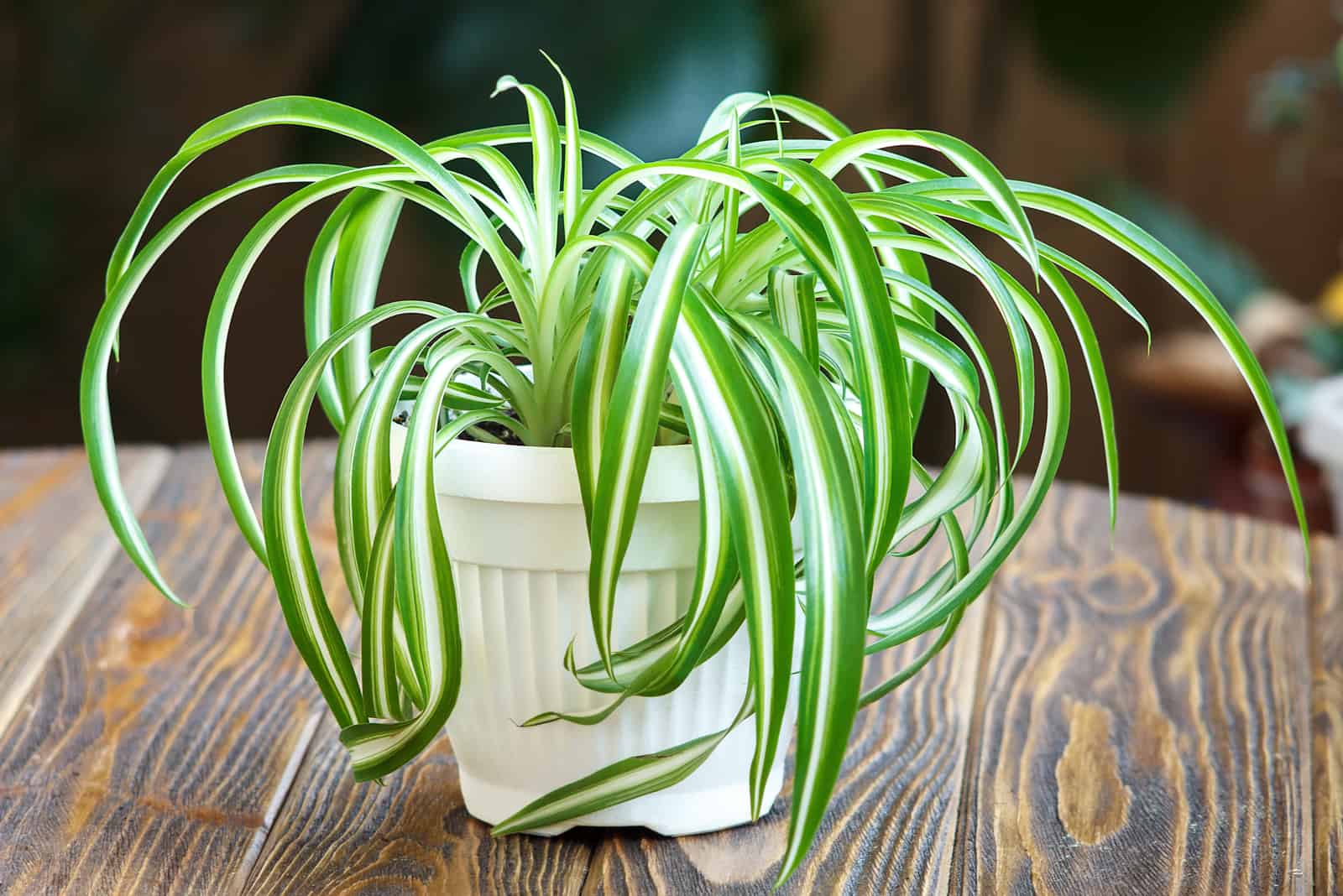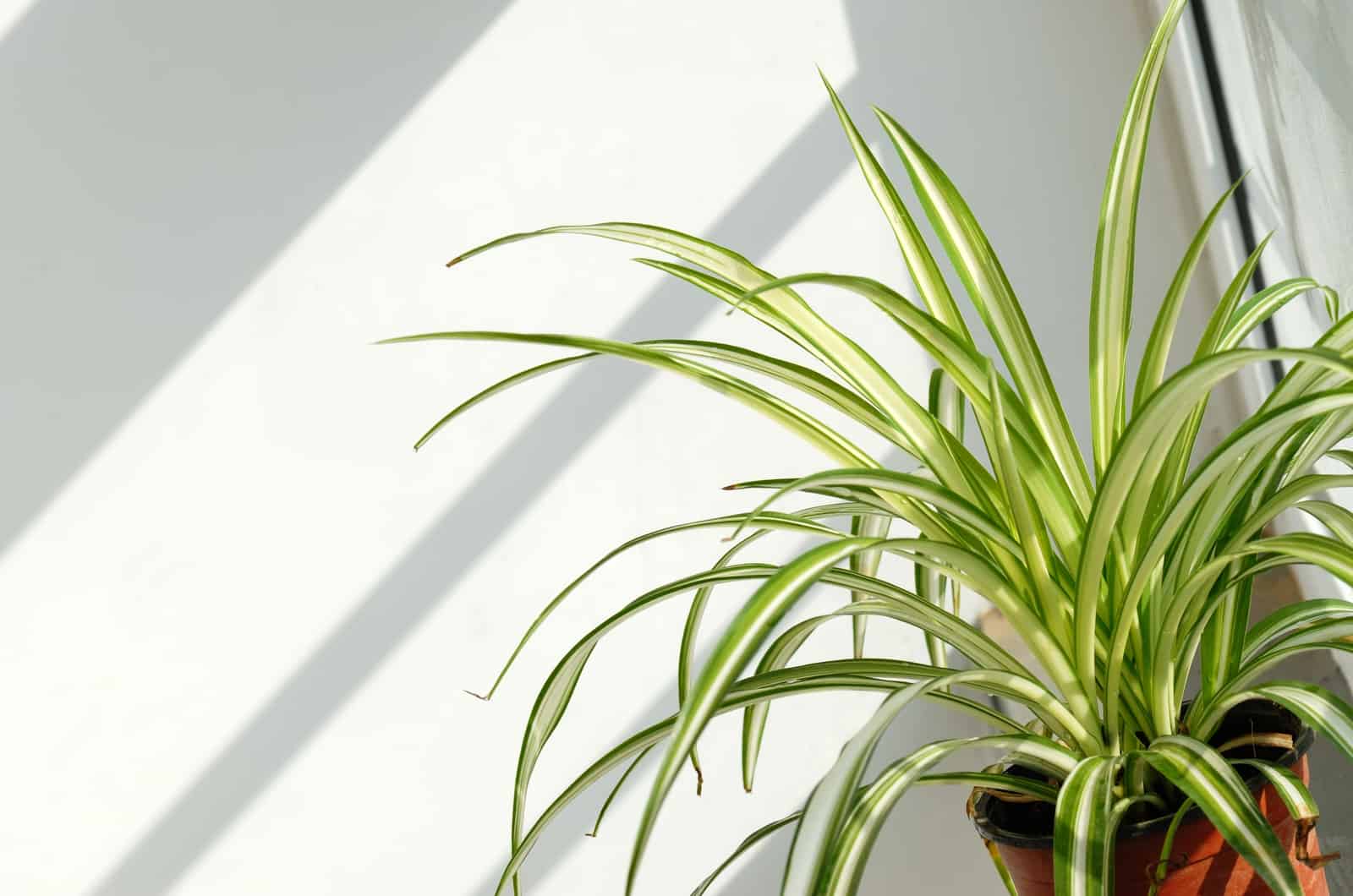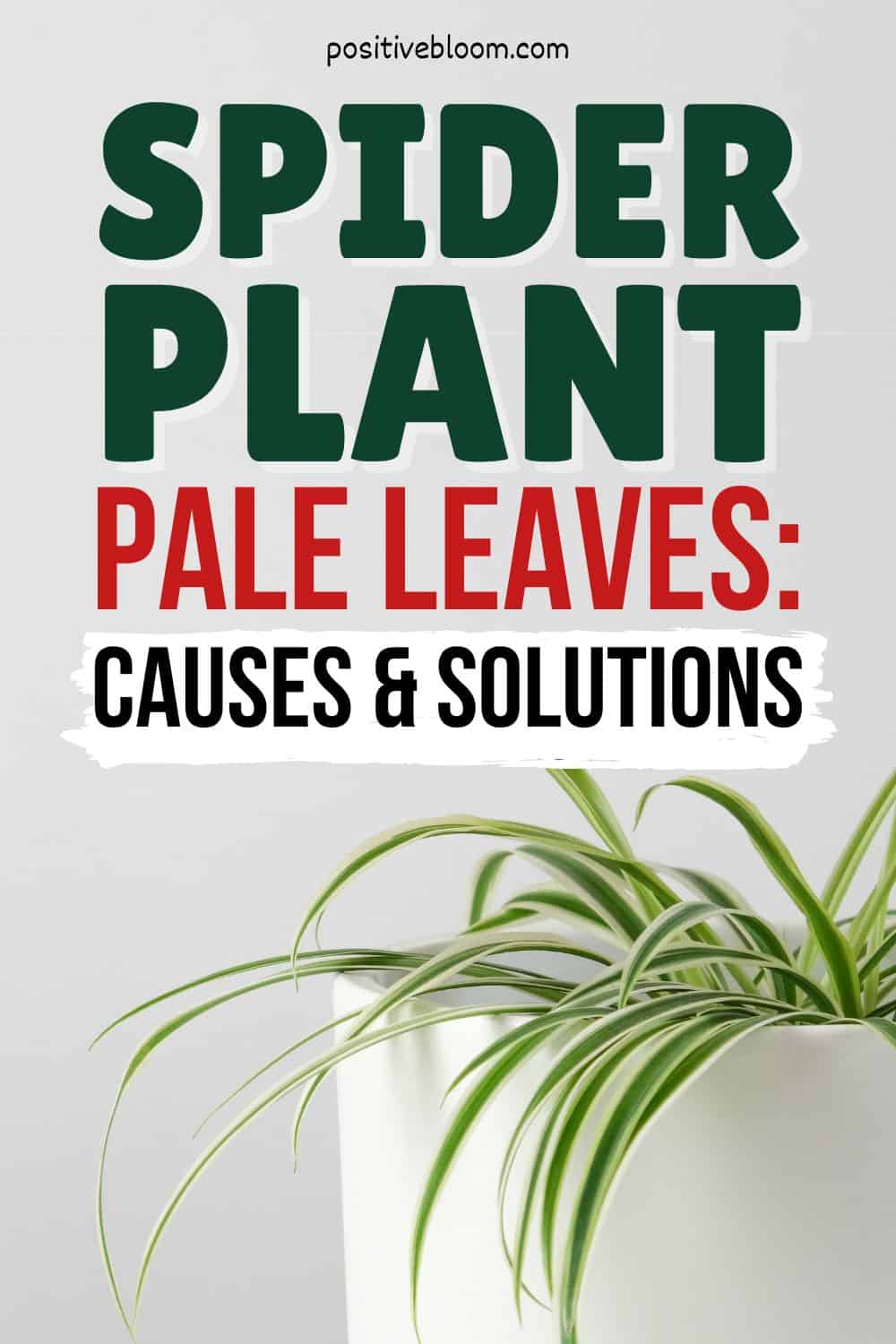The narrow, green leaves with white or yellow stripes are what make the spider plant stand out from other houseplants.
The spider plant is a classic in the plant world, and gardeners have grown it since the 1700s.
However, beauty isn’t the only thing this beautiful plant has; it is also a low-maintenance plant suitable for beginners.
Although the spider plant isn’t prone to leaf discoloration, inappropriate conditions often lead to it.
If you have spider plant pale leaves, it could be occurring for many reasons and it may take time to detect the cause, but it’s definitely worth it.
Before we move on, let’s look at some basic info about this plant.
[table id=200 /]Let’s get started!
Spider Plant Pale Leaves: Common Causes
Paling or yellowing of leaves is a bad sign in 95% of cases. In other words, something is wrong with your plant if you notice this affecting your leaves.
There’s nothing worse than an unhealthy plant, especially if you spent a lot of time caring for it.
Spider plants, like curly spider plants, aren’t fussy about growing conditions and can grow well even if you forget about them for a while.
However, problems can occur if your plant receives either not enough light or too much.
Inappropriate watering and fertilizing schedules may also be the reason for discoloration, as well as pests and the wrong type of water.
Yellowing may occur as a part of the spider plant life cycle, but that is a rare occurrence.
There are many possible causes of yellowing and paling, so let’s get to work!
Low Light
This may be a surprise, but spider plants may show signs of unhappiness if grown in low light.
Experienced gardeners know that spider plants adapt well to many conditions, and how much light spider plants can tolerate. Spider Ivy is one of the best low-light indoor plants, which makes it a perfect plant for offices with no windows.
It’s important for beginners to know what too much low light exposure will do to spider plants.
Although these plants may grow well in lower light, they still need some natural indirect light to grow as healthy as possible.
After your spider Ivy spends some time in low light, it will display pale leaves to warn you that it’s unhappy about the light exposure it’s getting.
Low light primarily affects the growth and appearance of variegated spider plants.
Direct Sunlight
If indoor plants could talk, they would definitely say that direct sunlight is their worst nightmare!
Sunny windows may sound like the perfect spot for our plants as they really emphasize their beauty, however, most houseplants originate from tropical regions and grow under the rainforest canopy, including the Spider plant.
The spider plant doesn’t receive much direct sun in its natural habitat.
The problem with direct sun is that it affects spider plants very quickly, which means that it can cause the leaves to turn pale in just a matter of days.
You may not notice changes in the beginning, but as the time passes your spider Ivy starts yellowing, and may even begin browning.
Luckily, your spider plant gives you enough time to fix the issue by showing these signs. If left exposed to direct sun for an extended period, well, you can guess what happens next…
So, brown tips, spots, paleness, and drooping are sure signs that your spider plant needs less light.
Overwatering
As you may know, overwatering is a common problem with indoor plants and plants in general.
Overwatering doesn’t happen only when you pour too much water at once.
Although it is one of the reasons, if the soil has poor drainage or you water your spider Ivy without checking the soil moisture first, you face overwatering.
We all want our plants to receive enough water, but the fact is that underwatering won’t cause as much damage as overwatering.
If you don’t remove the excess water, it will drown the roots and cause one of the most serious conditions for plants, the notorious root rot!
The Spider plant’s roots won’t send nutrients to other sections of the plant, including the leaves, if this happens, and as a result the spider Ivy’s leaves will turn yellow.
Signs Of An Overwatered Spider Plant
As well as yellow leaves, there are some other signs that indicate an overwatered ribbon plant, including:
• Moldy soil with a foul odor
• Brown spots on leaves
• Leaf edges and tips turn brown
• Curly leaves
If you notice your ribbon plant displaying these signs, you’ll need to take it out of the pot.
Excess water in the soil means that susceptibility to fungal infections is significantly increased.
For many plants, root rot means death, so you better react as fast as possible!
Pale Spider Plants Leaves: Underfeeding
Most low-maintenance plants aren’t heavy-feeders and grow well without frequent fertilization.
You may have heard of the dangers of overfertilization, so try to avoid this problem.
Though overfertilization is dangerous for plants, if they don’t receive enough food they won’t be happy either.
Fertilization can be tricky for beginners; you need to learn about the perfect nutrient ratio and arrange an appropriate fertilizing schedule.
Your spider Ivy will let you know it’s hungry by displaying pale leaves. Read on to find out how and when to fertilize your Chlorophytum comosum plant.
Overfertilization
The more dangerous extreme of feeding plants is overfertilization.
Too much fertilizer will change the soil for the worse by increasing the salt concentration, which usually leads to destroying beneficial soil microorganisms.
A couple of things can go wrong when it comes to fertilization. First, you may fertilize your spider Ivy too frequently.
Second, you may use the wrong fertilizer type with an improper npk ratio.
And lastly, if you don’t follow the instructions on the package, things can also go wrong.
Symptoms Of Overfertilization:
• Pale and wilting leaves
• Brown leaf tips
• Stunted growth
You might want to change your fertilizing habits if you notice any of these signs.
Leaves Turning Yellow And Pale: Pests
Leaf spots that turn brown or yellow over time are one of the most obvious symptoms that pests are wreaking havoc on your spider Ivy.
Annoying bugs that may inhabit spider Ivy leaves are aphids, mealybugs, whiteflies, and spider mites.
Ribbon plants infested by spider mites frequently develop yellow leaves. However, these troublesome creatures are tiny and you will notice discoloration before you spot them (how sneaky).
When inspecting the plant, always take a look at the undersides of the leaves because that’s where most pests hide.
What makes spider Ivy more attractive to pests is that its leaves are grouped in the central part of the plant, making it an ideal habitat for pests.
Wrong Type Of Water
Believe it or not, the type of water you use can also cause paleness of the leaves. The ribbon plant is selective about the water it gets, especially the amount of water.
We add chlorine to the water to make tap water safe to drink, but some households have water with an excessive amount of chlorine and fluoride. When these two chemicals build up in spider Ivy soil, they reach the roots.
Spider plants may be unhappy about the excess minerals and display pale leaves and brown tips in this case.
Rootbound Spider Ivy
Repotting is part of essential spider plant care, and skipping it puts your plant at risk of becoming rootbound.
A healthy plant should overgrow its pot no matter its growth habit and rate.
When the pot becomes too small for the roots to grow, your spider Ivy becomes rootbound.
As a result, the plant becomes weak and displays pale leaves as a sign of distress.
Your once fast-growing spider Ivy will now struggle to grow in this case.
Luckily, there is one sure sign that your spider Ivy needs repotting; its roots will start coming out of the drainage holes.
Old Leaves
It’s completely normal for older leaves to start turning yellow as a result of losing the ability to photosynthesize.
If you rule out all previously mentioned possible causes, you have nothing to worry about.
This may affect your spider Ivy’s appearance, and as the leaves won’t turn green anymore you should remove them.
How To Save Your Chlorophytum Comosum
Now that you know the possible causes of the pale leaves of your spider plant, it’s time to identify which one is responsible.
It’s time to save your spider Ivy and make it green again!
Adjust Light
If low light caused the paleness, you should give your ribbon plant more light to help it recover. The plant won’t mind if you expose it to direct light for a little while.
I highly recommend giving your spider Ivy some morning sun; it won’t cause damage and your plant will benefit.
Just a reminder not to leave your plant exposed for too long as it may end up suffering from more paleness due to direct sunlight.
These plants require approximately 8-10 hours of bright indirect light a day.
Where Is The Best Place For A Spider Ivy?
I suggest you place your spider plant near an east-facing window. By putting it there, you help it absorb the morning sun and avoid the strong afternoon sun.
You can also place your ribbon plant near a south or west-facing window about 5 feet away.
In the case of south and west-facing windows, you will need drapes or sheer curtains to provide shade and indirect sunlight.
Solution To Overwatering
To fix an overwatered spider Ivy, you will first need to change your watering habits. In other words, you will need a new watering schedule and a new watering method.
Additionally, you need to know which type of water is most suitable for the ribbon plant.
Let’s find out more!
When To Water A Spider Plant
The watering schedule for spider plants depends on the season and temperature.
For example, summer watering requirements for these plants are higher than winter watering requirements.
In the winter, these tropical plants enter dormancy for a period of rest and refreshment.
During the growing season, you will need to water your spider Ivy every couple of days. Temperatures are higher so the spider plants’ soil dries out quickly.
On the other hand, temperatures are lower during winter and the spider Ivy doesn’t grow actively, so you should cut back on watering; once or twice a month should be enough.
How To Check Moisture Levels
Here are some tips on how to check if your ribbon plant needs watering:
• By lifting the pot: if the spider plant’s pot feels light, it’s time for watering.
• By putting your finger or a wooden stick in the soil: stick your fingers in and check if the topsoil is dry.
• By using a moisture meter: this device precisely tells you if your plant lacks water.
• By checking the color: if the ribbon plant’s potting soil is lighter than usual, it’s time for watering.
How To Water Spider Plant
Many growers don’t think much about watering methods, but knowing more about this certainly helps with ribbon plant care.
You can choose between two watering methods: watering from above and watering from the bottom of the pot.
If you decide to water your spider Ivy from above, I strongly recommend avoiding watering the leaves. If they don’t dry well they may rot.
On the other hand, bottom watering requires a tray or larger container. Place a tray below your spider Ivy’s pot and fill it with water.
Wait for about 10 minutes and then remove the excess water from the tray. If you use a container, fill half of it with water and place your ribbon plant in it.
Wait a couple of minutes, lift your spider Ivy out, let it drain well, and that’s it!
Type Of Water
The type of water you use for spider plants is very important.
Some growers leave tap water to sit overnight to allow harmful chemicals to evaporate.
To be on the safe side you can use distilled water or rainwater.
Rainwater is good because it’s similar to a spider plant’s natural environment.
Pro tip: Use lukewarm water to avoid shock; water that’s either too cold or too hot may affect root growth.
New Fertilizing Schedule
Your spider Ivy needs more nutrients during the growing season for new growth. You can fertilize once or twice a month during spring and summer.
During the fall and winter, cut back on fertilizing as your ribbon plant is dormant and doesn’t need extra food.
I highly recommend using an all-purpose liquid fertilizer.
If you decide to fertilize your ribbon plant twice a month, be careful about salt build-up in the soil.
Sometimes it’s hard to see how deep the salts have penetrated into the soil. I advise replacing the soil with fresh and fertilizing once a month.
Remove Pests
You can use pesticides or certain natural remedies to eliminate pests. Of course, it’s always better to use natural options.
One such remedy is neem oil, which will help you remove many pests like aphids, spider mites, whiteflies, and mealybugs.
Here are a few useful tricks for if you decide to use neem oil:
• Stick to the instructions on the package.
• If your spider plant is dealing with a severe infestation, apply the neem oil solution every 5 days.
• Apply in the late afternoon or evening.
• Never apply neem oil on windy days.
Repot Your Plant
Spider plants require repotting once a year.
Here is a step-by-step guide for how to repot your spider plant:
1. Choose the appropriate pot: buy a pot about an inch larger than the previous one.
2. Prepare fresh potting mix: never use the old potting mix to avoid contamination.
3. Take your spider plant out of the pot: gently lift your spider plant from the pot and remove the soil to expose the root system. Be careful not to damage the root ball.
4. Inspect the root system: this is a great time to check if your spider plant has any mushy, black, or brown roots.
5. Remove any affected roots: You should remove any diseased roots, and sterilize the tools before each cut.
6. Place your spider plant in a new pot: fill half the pot with fresh soil and place the spider Ivy in the center. Add more soil and press it down around your plant.
Remember that this is a great time for propagation, and you can propagate the plantlets by stem cuttings in water, soil, or using the air-layering method.
Spider Plant Care Guide
So far, we’ve covered light, watering, fertilizing, pest removal, and repotting.
It’s now time to learn about the other conditions your spider plant needs in order to stay green and happy for a long time!
Humidity
Spider plants thrive in various humidity levels. Keep it anywhere between 40 and 80% and your spider Ivy will reward you by displaying its beautiful leaves.
Problems occur when the humidity drops below 40% because it’s far below the humidity found in the tropical regions these plants come from.
How can you tell if the humidity levels meet the ribbon plant’s requirements? I recommend purchasing a hygrometer, which is a device for measuring humidity.
Another convenient device that will help you maintain proper humidity is a humidifier.
I know that some growers like devices while others prefer natural things.
Here are three more methods for increasing humidity for my more natural readers:
1. Create a microclimate: place your ribbon Ivy next to other houseplants.
2. Place a humidity/pebble tray below the spider plant’s pot.
3. Humid rooms: kitchens and bathrooms are great places for ribbon plants.
Temperature
In their native habitats, spider Ivy plants grow in slightly higher temperatures.
Ideal temperatures for the Chlorophytum comosum range from 60 to 80 degrees Fahrenheit.
Ribbon plants are cold-resistant, though temperatures below 55 degrees Fahrenheit may cause damage.
Another enemy of spider plants are temperature fluctuations, so keep this Chlorophytum plant away from cold drafts and sudden temperature changes!
Potting Mix
Here are a couple of tips for choosing the best potting mix for ribbon plants:
• This plant requires slightly acidic soil, so you’ll need to keep pH from 6.0 to 6.5.
• Your spider Ivy needs a well-draining potting mix, so purchase regular potting soil and add perlite to help the soil drain better.
• The spider Ivy also requires fertile soil, so adding a little organic matter will do wonders.
• Another way to aid drainage is by using a pot with drainage holes.
Pruning
Ribbon plants benefit greatly from occasional trimming; it restores their strength and health.
You can’t just clip off leaf tips and expect better growth, so only cut off the spider plant’s leaves at the base of the plant.
You will need sharp and sterilized shears or pruners.
Don’t worry too much about pruning because you can do it once a year and still get great results.
However, if you notice dead leaves you should prune them.
FAQs
How does a spider plant grow?
Spider plants develop from roots called tubers. Each spider plant can produce several tubers, which means that plants can cover larger areas if you don’t divide or lift them. You should also avoid planting too many tubers as spider plants have a fast growth rate and will spread rapidly.
What type of plant is a spider plant?
Spider plants belong to the Chlorophytum genus, or the genus of the Asparagaceae family (asparagus plants). These plants are mostly grown as indoor ornamental plants.
Their long green leaves with white streaks make spider plants one of the most attractive houseplants. People have been growing them since the 1700s.
Wrapping Up
Chlorophytum comosum plants are undoubtedly worth growing. If you provide them with the right conditions, they will reward you by displaying breathtaking grassy green leaves with white streaks!
Even though they are low-maintenance plants, they aren’t immune to changes like discoloration.
So, if you have spider plant pale leaves your problems are now solved. Take good care of your ribbon plant because there is nothing better than watching it thrive.
Until next time!
Like this post? Share or pin it for later!

